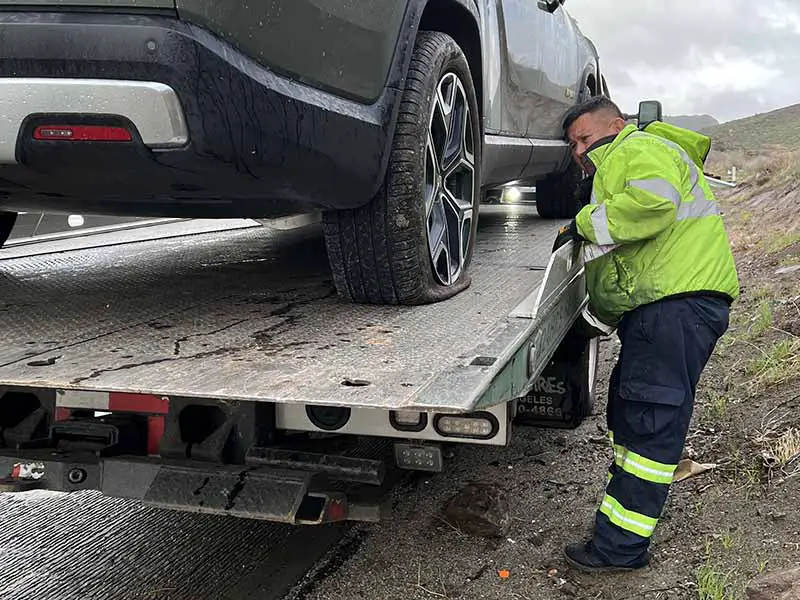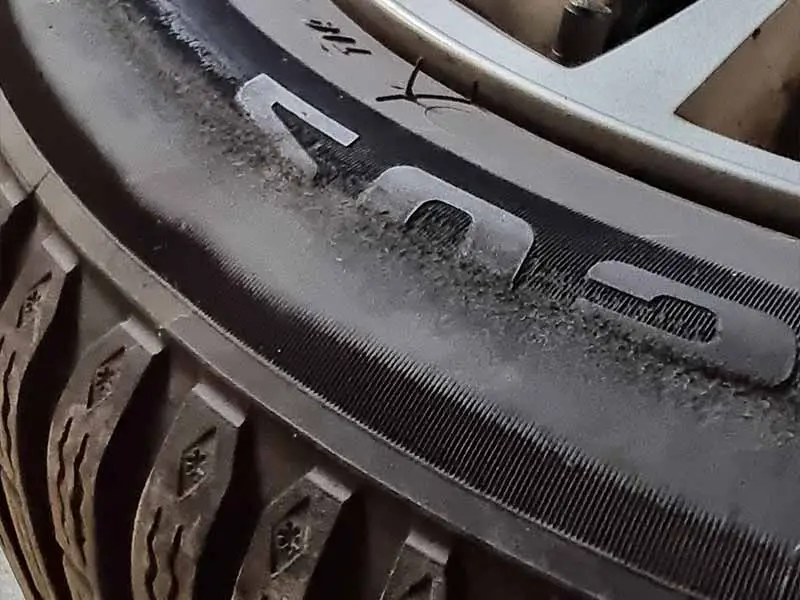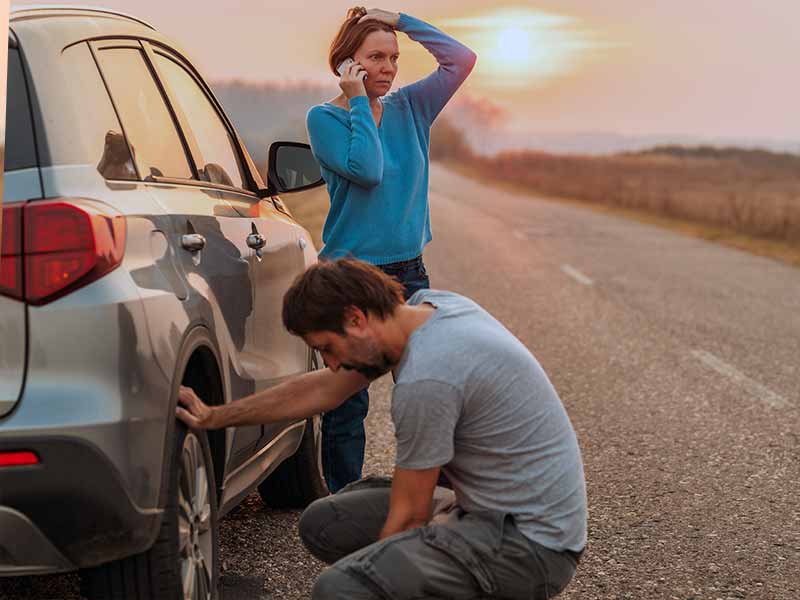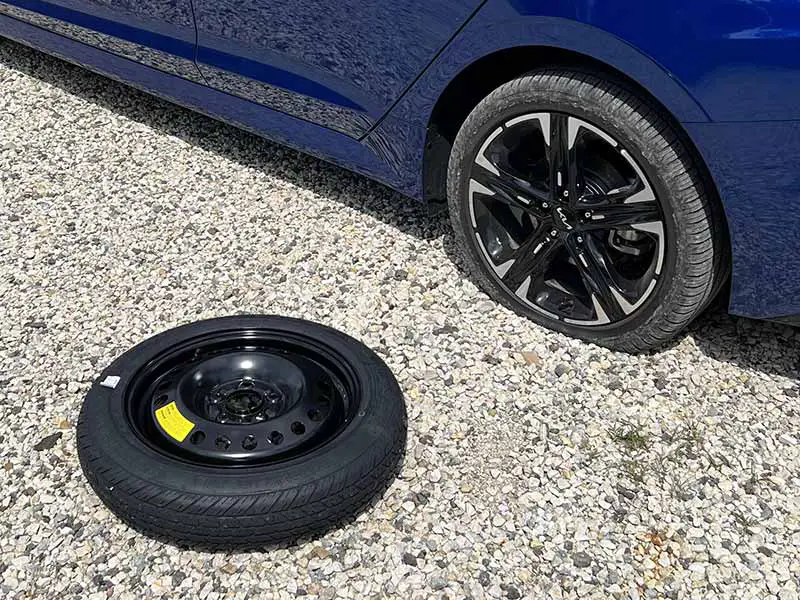Driving on a flat tire? You might be cruising down a road more dangerous than you think. The issue goes beyond a shaky ride or reduced control—it’s about the unseen damage that can have severe implications. Enter tire sidewall damage and the ominous heat ring, a silent tire destroyer that lurks beneath the surface.
Tire Sidewall Damage From Driving On Flat
Driving on a flat tire can indeed cause severe damage, particularly to the tire sidewall.
The generated heat can lead to an internal injury known as a heat ring, which weakens the tire’s structure and necessitates tire replacement.
In this article, we’ll dive deep into the world of tire sidewall damage, focusing on how driving on a flat tire can lead to a heat ring. We’ll explore the structure of a tire, the role of the sidewall, the impact of a flat or underinflated tire, and tips to prevent such damage.
Let’s take a closer look.

The Effects of Driving on a Flat Tire
What happens if you ignore the warning signs and decide to drive on a flat tire. Spoiler alert: It’s not good news!
Can Driving on a Flat Tire Ruin it?
In a word, yes. Driving on a flat tire can do a whole lot of damage, and here’s why:
- Increased Sidewall Damage: With a flat tire, your vehicle’s weight rests on the sidewall, not on the tread as it should. This can crush or cut the sidewall, causing irreversible damage.
- Heat Build-up: Driving on a flat causes a lot of friction, and this leads to heat. This can lead to heat ring damage and in extreme cases, can cause the tire to fail completely.
- Potential for a Blowout: As a damaged tire heats up and weakens, it could eventually blow out, especially at high speeds. This is not just bad for your tire; it could cause a serious accident.
How Much Sidewall Damage is Acceptable?
Think of a tire as a shield. Would you go into battle with a shield that’s been hacked and battered? Probably not.
The same goes for your tire. Any damage to the sidewall compromises your tire’s structural integrity. Minor scuffing might not be a huge deal, but cuts, punctures or bulges in the sidewall should be treated seriously.
In general, it’s better to be safe than sorry. If you see damage on the sidewall of your tire, get it inspected by a tire technician as soon as possible.
What Happens When a Tire is Punctured?
When your tire gets punctured, air leaks out. If the puncture is small, it might leak slowly, leading to an underinflated tire. But a large puncture could cause a rapid air loss, which can make your tire go flat quickly.
A punctured tire can become a damaged tire quickly, especially if it’s driven on. The decrease in air pressure means the sidewall has to flex more to carry the vehicle’s weight. This can lead to more heat and more potential damage.

What is Tire Heat Ring Damage?
Let’s now shift our focus to a specific type of tire damage: Tire heat ring damage. It’s a unique problem that can result from driving on a flat or even just an underinflated tire. But what exactly is it, and why does it mean a new tire is in your future?
Unpacking Heat Ring Damage
Imagine for a moment, you’re driving along, and your tire is underinflated or worse, flat. What happens? Well, as you roll along, that tire is going to flex more than it’s designed to. This excessive flexing generates heat, and over time, that heat can lead to what’s known as a heat ring.
A heat ring is essentially an area of internal damage that forms around the tire, usually within the sidewall. It might not be visible from the outside, but it can seriously compromise the tire’s structural integrity. The heat affects the internal structure of the tire, causing it to degrade. It can weaken the tire’s structure to the point where it’s no longer safe to drive on.
Why Can’t Heat Ring Damage Be Repaired?
So, why can’t you repair a tire with heat ring damage? Here’s the crux of the issue: Heat ring damage is internal. It’s not a puncture or a simple cut that you could patch or plug. Instead, it’s a breakdown of the tire’s very structure.
Here’s why this is such a problem:
- It’s Not Visible: One of the biggest challenges with heat ring damage is that it’s often not visible from the outside. This means it can’t be located and patched like a puncture.
- Structural Compromise: The heat generated by driving on a flat or underinflated tire doesn’t just affect one spot. It affects a whole section of the tire, degrading its internal structure. This can lead to a blowout or complete tire failure.
- Safety Risk: Lastly and most importantly, driving on a tire with heat ring damage is a serious safety risk. Because the damage is internal and often extensive, the tire is much more likely to fail, especially at high speeds or under heavy loads.
Special Cases: Run Flat Tires
Alright, let’s dive into something a bit special: Run flat tires. They’ve been a game changer in the world of tires, especially when it comes to handling punctures. But what are they, and how do they stack up when it comes to sidewall damage?
The Magic of Run Flat Tires
Run flat tires are like the superheroes of the tire world. They have special technology that allows them to keep performing even when they lose all air pressure. Yep, you heard it right!
This is made possible through one of two designs:
- Self-Supporting: These tires have thicker, reinforced sidewalls that can support the vehicle’s weight even if the tire loses all air pressure.
- Support Ring: These tires use a rigid ring of rubber or another material that can support the vehicle’s weight in the event of a total loss of air pressure.
So, if you experience a puncture, you can keep driving for about 50 to 100 miles at a reduced speed (usually up to 50 mph), enough to get you to the nearest tire shop. No roadside tire change necessary!
Balancing the Benefits and Limitations
So, are run flat tires a good option? Well, it depends on your priorities. If you want the peace of mind that comes from being able to drive on a flat tire, they could be a great choice. But remember, they might not be as forgiving of certain types of damage, and when they get damaged, it usually means buying a new tire.

What to Do When Your Tire Goes Flat While Driving
No one wants to experience a flat tire, especially while driving. But knowing what to do if this happens can make all the difference. Here’s your step-by-step guide to handling a flat tire on the go.
Keep Calm and Steady On
The first rule is don’t panic. Yes, it’s easier said than done. But freaking out won’t fix your flat tire. So, take a deep breath and follow these steps:
- Don’t Slam on the Brakes: It’s a natural instinct to want to stop quickly, but slamming on the brakes could cause you to lose control. Instead, ease off the gas pedal and let your car slow down naturally.
- Keep a Firm Grip: Your steering wheel might start to shake or pull in one direction. Hold it firmly and keep your car as straight as possible.
- Look for a Safe Place to Pull Over: Ideally, this should be a flat area away from traffic. A parking lot or a wide shoulder on the highway would work.
Changing the Tire
Once you’ve safely pulled over, it’s time to put that spare tire to work:
- Put on Your Emergency Brake: This is to make sure your car doesn’t roll while you’re changing the tire.
- Take Out Your Spare Tire and Tools: These should be in your trunk. You’ll need a jack, a lug wrench, and of course, your spare tire.
- Loosen the Lug Nuts: Do this while the tire is still on the ground. It’s easier this way.
- Use the Jack: Position it under your car (check your car’s manual to find the right spot) and raise your car off the ground.
- Remove the Flat Tire: Unscrew the lug nuts the rest of the way and then pull the tire off.
- Mount the Spare Tire: Put it on, screw the lug nuts as tight as you can, lower the car back to the ground, and then tighten the lug nuts again.
After Changing the Tire
Once you’ve got the spare tire on:
- Drive to the Nearest Tire Shop: Spare tires aren’t meant for long trips or high speeds. They’re a temporary fix to get you to a place where you can repair or replace the damaged tire.
- Inspect the Damaged Tire: Have a tire technician check out your damaged tire. They can tell you whether it’s repairable or if it’s time for a new tire.

Tips to Prevent Tire Sidewall Damage
Here’s the deal: even the best of us can face tire troubles. But there’s a lot you can do to prevent tire sidewall damage. So, let’s switch gears and talk about how you can keep your tires in tip-top shape.
Regularly Check Your Tire Pressure
This one’s a biggie. You should check your tire pressure at least once a month. Underinflated tires flex more, which generates heat and increases the risk of damage and blowouts. Overinflated tires, on the other hand, make the tire hard and more susceptible to impact damage. So, get yourself a good tire pressure gauge and use it!
Avoid Road Hazards
Look, we get it. Potholes, curbs, and road debris aren’t always avoidable. But try your best. Hitting a deep pothole or clipping a sharp curb can cause immediate and severe damage to your tire’s sidewall.
Rotate Your Tires Regularly
This helps ensure even wear, which can prolong the life of your tires. Most tire manufacturers recommend rotating your tires every 5,000 to 8,000 miles. But always check your vehicle owner’s manual for specific recommendations.
Resources
Below are some links you may find helpful when learning about tires
Final Thoughts
Driving on a flat or underinflated tire isn’t just a temporary inconvenience—it can lead to serious, often invisible, damage such as heat rings that compromise your tire’s structural integrity.
Remember, the best defense against sidewall damage is proactive care and vigilance. Regularly check your tire pressure, rotate your tires, avoid road hazards when possible, and replace worn-out tires promptly. Even the special case of run flat tires, while a game changer, still requires your attention.
Good luck and happy motoring.



